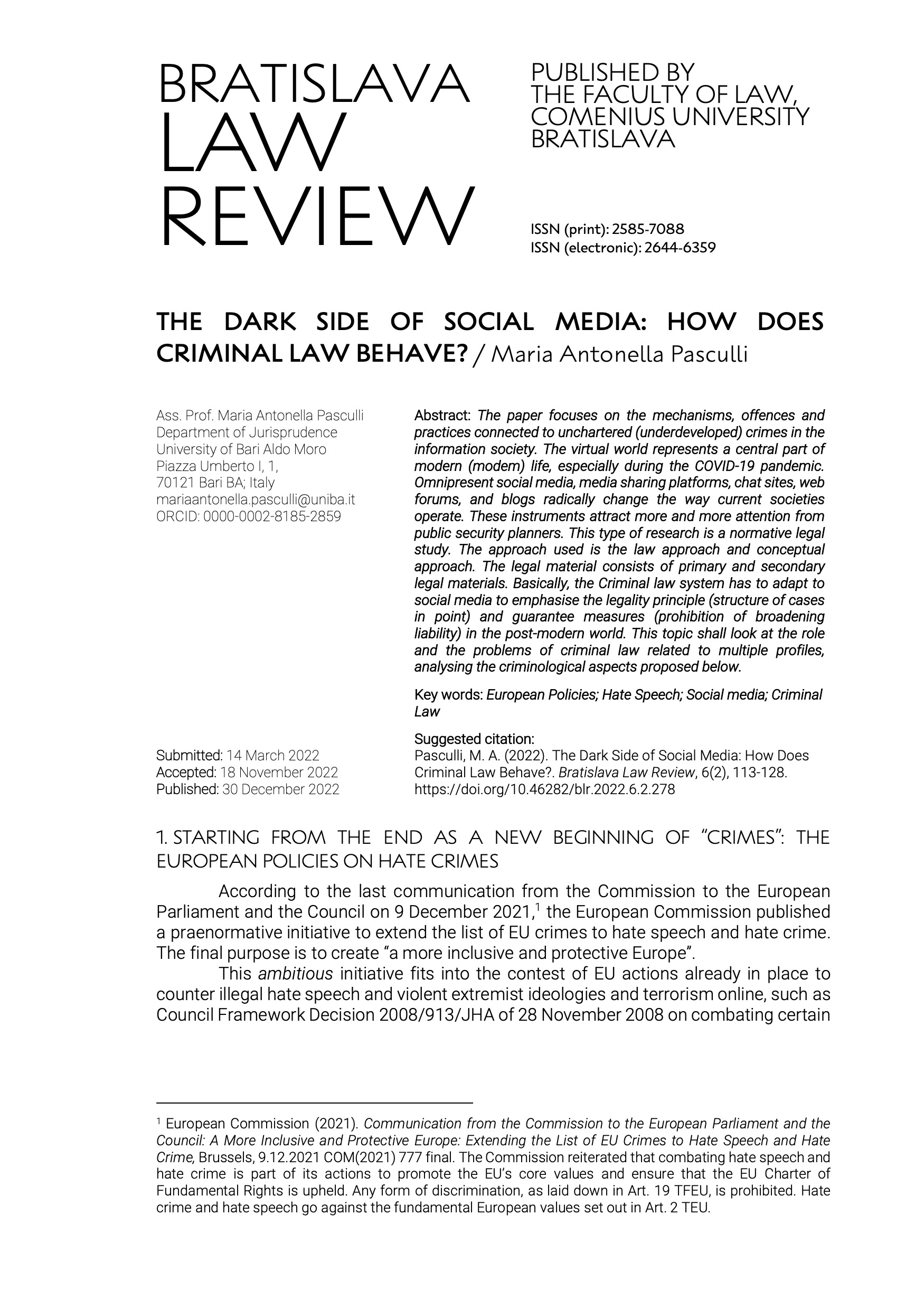The Dark Side of Social Media
How Does Criminal Law Behave?
DOI:
https://doi.org/10.46282/blr.2022.6.2.278Keywords:
European Policies, Hate Speech, Social media, Criminal LawAbstract
The paper focuses on the mechanisms, offences and practices connected to unchartered (underdeveloped) crimes in the information society. The virtual world represents a central part of modern (modem) life, especially during the COVID-19 pandemic. Omnipresent social media, media sharing platforms, chat sites, web forums, and blogs radically change the way current societies operate. These instruments attract more and more attention from public security planners. This type of research is a normative legal study. The approach used is the law approach and conceptual approach. The legal material consists of primary and secondary legal materials. Basically, the Criminal law system has to adapt to social media to emphasise the legality principle (structure of cases in point) and guarantee measures (prohibition of broadening liability) in the post-modern world. This topic shall look at the role and the problems of criminal law related to multiple profiles, analysing the criminological aspects proposed below.
References
ADL. Pyramid of Hate. Available at: https://www.adl.org/sites/default/files/documents/pyramid-of-hate.pdf (accessed on 15.11.2022).
Amnesty International Sezione Italiana (2020). Hate speech: conoscerlo e contrastarlo. Available at: https://d21zrvtkxtd6ae.cloudfront.net/public/uploads/2021/02/Amnesty-Manuale-hate-speech-2020-con-logo-1.pdf (accessed on 15.11.2022).
Chirico, S., Gori, L. and Esposito, I. (2020). When Hate Becomes Crime. Hate Crime: What It Is And The Legal Framework Against It. Special Issue Polizia Moderna. Available at:https://www.interno.gov.it/sites/default/files/allegati/when_hate_becomes_crime-_oscad.pdf (accessed on 15.11.2022).
Coe, P. (2015). The Social Media Paradox: An Intersection with Freedom of Expression and the Criminal Law. Information and Communications Technology Law, 24(1), 16–40. DOI: https://doi.org/10.1080/13600834.2015.1004242 DOI: https://doi.org/10.1080/13600834.2015.1004242
Council Framework Decision 2004/68/JHA of 22 December 2003 on combating the sexual exploitation of children and child pornography. OJ L 13/44, 20.01.2004, pp. 44-48. Available at: https://eur-lex.europa.eu/legal-content/EN/TXT/?uri=OJ%3AL%3A2004%3A013%3ATOC (accessed on 15.11.2022).
Council Framework Decision 2008/913/JHA of 28 November 2008 on combating certain forms and expressions of racism and xenophobia by means of criminal law. OJ L 328, 6.12.2008, pp. 55–58. Available at: http://data.europa.eu/eli/dec_framw/2008/913/oj (accessed on 15.11.2022).
Council of Europe. Global Project on Cybercrime, Protecting Children against Sexual Violence: the Criminal Law Benchmarks of the Budapest and Lanzarote Conventions (Discussion paper), December 2012. Available at: https://rm.coe.int/16802fa3e2 (accessed on 15.11.2022).
Deflem, M. and Silva, D. (2021). Media and Law: Between Free Speech and Censorship (Sociology of Crime Law and Deviance). Bingley: Emerald Publishing. DOI: https://doi.org/10.1108/S1521-6136202126
Directive (EU) 2018/1808 of the European Parliament and of the Council of 14 November 2018 amending Directive 2010/13/EU on the coordination of certain provisions laid down by law, regulation or administrative action in the Member States concerning the provision of audiovisual media services. OJ L 303, 28.11.2018, p. 69–92. Available at: https://eur-lex.europa.eu/eli/dir/2018/1808/oj (accessed on 15.11.2022).
Dombrowski, S. C., LeMasney, J. W., Dickson, S. A. and Ahia, C. E. (2002). Protecting Children From Online Sexual Predators: Technological, Psychoeducational, and Legal Considerations. Professional Psychology: Research and Practice, 35(1), 65–73. DOI: https://doi.org/10.1037/0735-7028.35.1.65 DOI: https://doi.org/10.1037/0735-7028.35.1.65
Edwards, J. (2018). Theories of Criminal Law. The Stanford Encyclopaedia of Philosophy (Fall 2021 Edition), first published Mon Aug 6, 2018. Available at: https://plato.stanford.edu/archives/fall2021/entries/criminal-law/ (accessed on 15.11.2022).
European Commission (2019). Assessment of the Code of Conduct on Hate Speech on line. State of Play. Brussels, 27 September 2019, 12522/19. Available at: https://www.statewatch.org/media/documents/news/2019/oct/eu-com-assessing-code-of-conduct-online-hate-speech-12522-19.pdf (accessed on 15.11.2022).
European Commission (2021). Communication from the Commission to the European Parliament and the Council: A More Inclusive and Protective Europe: Extending the List of EU Crimes to Hate Speech and Hate Crime, Brussels, 9.12.2021 COM(2021) 777 final.
Furedi F. (2020). Social Distancing, Safe Spaces and the Demand for Quarantine. Society, 57(4), 392–397. DOI: 10.1007/s12115-020-00500-8 DOI: https://doi.org/10.1007/s12115-020-00500-8
Gillespie, A. (2002). Child Protection on the Internet - Challenges for Criminal Law. Child & Family Law Quaterly, 14(4), 411–425.
Harawa, D. S. (2014). Social Media Thoughtcrimes. Pace Law Review (Symposium: Social Media and Social Justice), 35(1), 366–397. Available at: https://digitalcommons.pace.edu/plr/vol35/iss1/13/ (accessed on 15.11.2022).
Heinze, A. (2022). Social Media and Criminal Law. Dublin: Clarus Press.
Henry, N. and Powell, A. (2016). Sexual Violence in the Digital Age: The Scope and Limits of Criminal Law. Social & Legal Studies, 25(4), 397–418. DOI: https://doi.org/10.1177/0964663915624273 DOI: https://doi.org/10.1177/0964663915624273
Higson-Bliss, L. (2020). Legality, Social Media and the Criminal Law (Doctoral Thesis). Date of Award: 15 April 2020. Available at: https://research.edgehill.ac.uk/ws/portalfiles/portal/28796517/PHD_LB_.pdf (accessed on 15.11.2022).
Jurasz O. and Barker, K. (2021). Sexual Violence in the Digital Age: A Criminal Law Conundrum?. German Law Journal, 22(5), 784–799. DOI: 10.1017/glj.2021.39 DOI: https://doi.org/10.1017/glj.2021.39
Khalifa, A. (2020). Overcoming The Conflict of Jurisdiction in Cybercrime [Master's Thesis, the American University in Cairo]. AUC Knowledge Fountain. Available at: https://fount.aucegypt.edu/etds/846 (accessed on 15.11.2022).
Klip, A. (2014). Section IV – International Criminal Law. Information Society and Penal Law. General Report. Revue Internationale De Droit Pénal, 85(1), 2014, 381–428. DOI: 10.3917/ridp.851.0381 DOI: https://doi.org/10.3917/ridp.851.0381
Lenhart, A. and Madden, M. (2007). Teens, privacy & online social networks: How teens manage their online identities and personal information in the age of MySpace. Washington, DC: Pew Internet & American Life Project. Available at: https://www.pewresearch.org/internet/wp-content/uploads/sites/9/media/Files/Reports/2007/PIP_Teens_Privacy_SNS_Report_Final.pdf.pdf (accessed on 15.11.2022).
Livingstone, S. and Haddon, L. (2009). EU Kids Online: final report 2009. LSE, London: EU Kids Online. Available at: https://eprints.lse.ac.uk/24372/1/EU%20Kids%20Online%20final%20report%202009%28lsero%29.pdf (accessed on 15.11.2022). DOI: https://doi.org/10.46692/9781847427342
Livingstone, S., Kirwil, L., Ponte, C. and Staksrud, E. (2014). In Their Own Words: What Bothers Children Online? European Journal of Communication, 29(3), 271-288. DOI: https://doi.org/10.1177/0267323114521045 DOI: https://doi.org/10.1177/0267323114521045
OECD (2011). The Protection of Children Online: Risks Faced by Children Online and Policies to Protect Them. OECD Digital Economy Papers, No. 179. Paris: OECD Publishing. DOI: https://doi.org/10.1787/5kgcjf71pl28-en DOI: https://doi.org/10.1787/5kgcjf71pl28-en
OECD (2020). Protecting children online: An overview of recent developments in legal frameworks and policies. OECD Digital Economy Papers, No. 295. Paris: OECD Publishing. DOI: https://doi.org/10.1787/9e0e49a9-en DOI: https://doi.org/10.1787/9e0e49a9-en
Ofcom (2010). UK children's media literacy 2010. Published on 26 March 2010. Available at: https://www.ofcom.org.uk/research-and-data/media-literacy-research/childrens/ukchildrensml (accessed on 15.11.2022).
OSCE Office for Democratic Institutions and Human Rights (2009). Hate Crime Laws - A Practical Guide. Available at: https://www.osce.org/odihr/36426 (accessed on 15.11.2022).
OSCE ODIHR. Hate Crime Reporting. Italy. Available at: https://hatecrime.osce.org/italy (accessed on 15.11.2022).
Policy Department for Citizens’ Rights and Constitutional Affairs (2020). Hate speech and hate crime in the EU and the Evaluation of Online Content Regulation Approaches. PE 655.135, July 2020. Available at: https://www.nigdywiecej.org//docstation/com_docstation/20/hate_speech_and_hate_crime_in_the_eu_and_the_evaluation_of_online_content_reg.pdf (accessed on 15.11.2022).
Prieto Curiel, R., Cresci, S., Muntean, C.I. and Bishop, S. R. (2020). Crime and Its Fear in Social Media. Palgrave Communications, 6(57), 1-12. DOI: https://doi.org/10.1057/s41599-020-0430-7 DOI: https://doi.org/10.1057/s41599-020-0430-7
Quayle, E., Allegro, S., Hutton, L., Sheath, M. and Lööf, L. (2014). Rapid Skill Acquisition and Online Sexual Grooming of Children. Computers in Human Behavior, 39, 368–375. DOI: https://doi.org/10.1016/j.chb.2014.07.005 DOI: https://doi.org/10.1016/j.chb.2014.07.005
Regulation (EU) 2021/784 of the European Parliament and of the Council of 29 April 2021 on addressing the dissemination of terrorist content online. OJ L 172, 17.5.2021, p. 79 – 109. Available at: https://eur-lex.europa.eu/legal-content/EN/TXT/?uri=celex%3A32021R0784 (accessed on 15.11.2022).
Salter, M. (2017). Crime, Justice and Social Media. London and New York: Routledge. DOI: https://doi.org/10.4324/9781315687742
Schurgin O'Keeffe G., Clarke-Pearson K. and Council on Communications and Media (2011). The impact of social media on children, adolescents, and families. Pediatrics, 127(4), 800–804. DOI: 10.1542/peds.2011-0054 DOI: https://doi.org/10.1542/peds.2011-0054
Simpson, B. (2018). Young People, Social Media and the Law. London, NY: Routledge DOI: https://doi.org/10.4324/9781315747484
Staksrud, E. (2013). Children in the Online World: Risk, Regulation, Rights (1st ed.). London: Routledge. DOI: https://doi.org/10.4324/9781315571508 DOI: https://doi.org/10.4324/9781315571508
Surette, R. (2014). Media, Crime, and Criminal Justice: Images, Realities, and Policies. Boston: Cengage Learning.
The EU Code of conduct on countering illegal hate speech online. The robust response provided by the European Union. In European Commission. Available at: https://ec.europa.eu/info/policies/justice-and-fundamental-rights/combatting-discrimination/racism-and-xenophobia/eu-code-conduct-countering-illegal-hate-speech-online_en#theeucodeofconduct (accessed on 15.11.2022).
Wilson, R. A. and Land, M. (2021). Hate Speech on Social Media: Content Moderation in Context. Faculty Articles and Papers. 535. Available at: https://opencommons.uconn.edu/law_papers/535 (accessed on 15.11.2022).
Wolak, J., Mitchell, K. and Finkelhor, D. (2006). Online victimization of Youth: Five Years Later. National Center for Missing & Exploited Children Bulletin, Alexandria, VA. Available at: https://www.unh.edu/ccrc/resource/online-victimization-youth-five-years-later (accessed on 15.11.2022). DOI: https://doi.org/10.1037/e525892015-001
Xiaobing, L. and Yongfeng, Q. (2018). Research on Criminal Jurisdiction of Computer Cybercrime. Procedia Computer Science, 131(C), 793–799. DOI: https://doi.org/10.1016/j.procs.2018.04.263 DOI: https://doi.org/10.1016/j.procs.2018.04.263

Downloads
Published
Issue
Section
Categories
License
Copyright (c) 2022 Bratislava Law Review

This work is licensed under a Creative Commons Attribution-NonCommercial-NoDerivatives 4.0 International License.
The Author(s) transfers copyright to the Article to the Publisher of the Journal by the Licence Agreement.
The Author(s) retains rights specified in the Licence Agreement.
The readers may read, download, copy, distribute, print, search, or link to the full texts of all of the Article of the Journal and use them for any other lawful purpose under specified Creative Commons Licence (CC BY-NC-ND 4.0).











